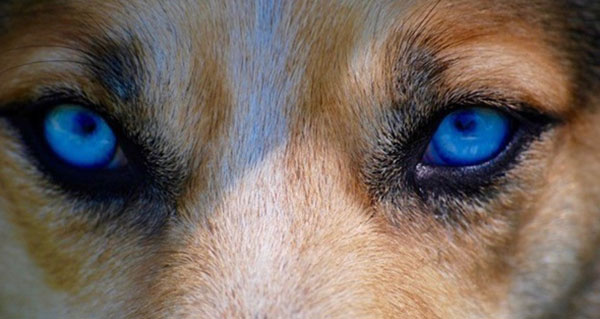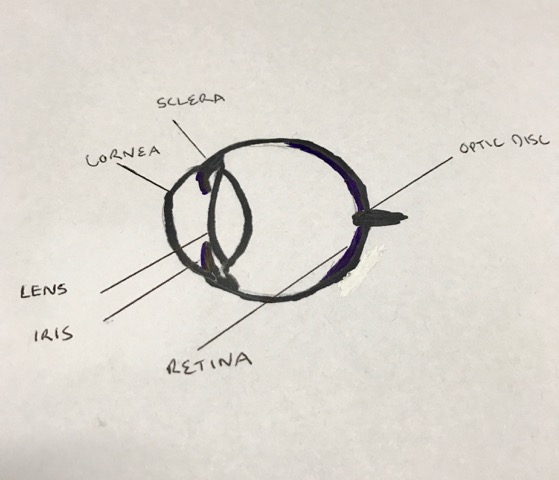The eyes are an important part of communicating with our pets. There are very few people who can resist the sight of a big pair of brown (or blue or green!) eyes asking for a pat or treat.
As veterinarians what are the most common eye issues we see in dogs and cats?
Eye ulcers:
An eye ulcer occurs what there is damage to the cornea of the eye. Ulcers may be caused by a range of issues such as trauma when they walk into things, injuries when playing with their friend (or enemy!), irritation by extra eyelashes, or by hair when the eyelids are not properly aligned, or other diseases such as Herpes virus in cats. Eye ulcers are usually diagnosed by applying a special dye to the eye which will highlight the ulcer. Eye ulcers are considered to be very painful so the sooner we see a pet with a suspected eye ulcer the sooner we can give them some pain relief plus medication to treat the ulcer.
Nuclear Sclerosis:
Nuclear sclerosis is a very common aging change of the lens of the eye in dogs and is considered a normal finding in middle age to older dogs. The lens of dogs affected by nuclear sclerosis appears blue grey. Nuclear sclerosis may slightly affect the vision as it advances but it should not cause blindness. The veterinarian can tell the difference between common nuclear sclerosis and the less common and more serious cataract formation by looking through the lens of the eye to the retina using a special light.
Cataracts:
Cataracts are a much more serious condition where the lens becomes completely white and can eventually seriously affect vision. Cataracts may be caused by a range of health conditions:
* in some breeds cataract formation may be inherited
* some cataracts are caused by injury to the eye
* rarely cataracts can be caused by medication
* sometimes cataracts can be caused by inflammation caused by other eye conditions such as PRA (progressive retinal atrophy)
* one of the most important causes of cataracts is uncontrolled diabetes. So if you noticed your pet developing a cloudy lens it is well worth a visit to the vet to check for underlying problems.
If your pet develops cataracts it is possible a specialist ophthalmologist could perform surgery to correct the condition once underlying health conditions are ruled out or controlled.
PRA (progressive retinal atrophy):
PRA is a degenerative condition of the retina which has the potential to lead to blindness. It is considered an inherited condition in some breeds such as poodles, collies and labrador retrievers but can be found in any breed including mixed breed dogs. The first symptom of PRA is often loss of vision at night followed by gradual loss of vision during the day. Fortunately PRA is not considered painful and as it is generally slowly progressive dogs can adjust to vision loss and will manage well in their home environment. PRA is diagnosed by looking at the retina using a special light called an ophthalmoscope.
Dry eye:
Dry eye is a condition where your dog stops producing enough tears to lubricate the eye. Affected eyes often have a thick crusty discharge and if left untreated pigment may develop on the cornea that has the potential to affect vision. To check for dry eye your veterinarian may perform a special test called a Schirmer tear test. Treatment usually involves eye drops, and is usually required for the rest of your dog’s life.
Glaucoma:
Glaucoma usually presents as a very painful red eye. Glaucomatous eyes have increased pressure of the fluid within the eye, and if left untreated has the potential to lead to blindness. If your dog or cat develops an acutely painful, red eye it is important to have them examined by a vet, who may suggest checking the pressure within the eye and if the pressure is high medical treatment will be initiated to hopefully prevent permanent vision loss.
Conjunctivitis:
Conjunctivitis is inflammation of the conjunctiva or tissues around the eye. It may be caused by a range of allergic, infectious and inflammatory conditions. Fortunately most causes can be treated or managed medically although on rare occasions surgery may be recommended. Your veterinarian will potentially perform a number of tests to check for other conditions that can cause pain and inflammation of the eye such as eye ulcers and will then develop a management plan.
Eyelid masses:
Eyelid masses are relatively common in dogs, and fortunately most are considered benign. If you noticed an eyelid mass on your dog or cat it is well worth having it checkout by your vet to develop a treatment plan before the mass gets big.
If you notice anything unusual with your pet’s eyes, take your pet to the vet to have it checked out ASAP.


